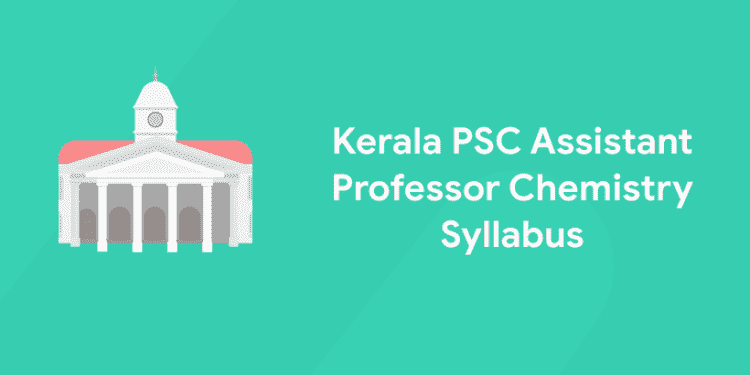Kerala PSC conducts the Assistant Professor examination to fill vacant positions under the Kerala Collegiate Education department. The last notification for the same was released in December. Candidates having a Masters’s Degree in the subject concerned with not less than 55% marks and a pass in Comprehensive Test in the subject concerned specifically conducted for the purpose by UGC (NET) can ONLY apply. Those who are preparing for the exam can download the concerned syllabus from Entri. Download the Assistant Professor Chemistry Syllabus from below.
Check the Kerala PSC Exam Syllabus of Various Examinations 2020-21.
Assistant Professor Chemistry Syllabus
Module 1- Inorganic Chemistry-1
- Structure and bonding in molecules- Chemical periodicity- Chemistry of Hydrogen and s block elements- Chemistry of p block elements and d block elements- Extractive chemistry of various metals of commercial importance- Chemistry of Nontransition elements like Glass.
- Theories of acids and bases- HSAB concept- solvent effects, linear free energy relationship – mechanism and methods of determination, superacids – Reactions in Nonaqueous solvents- Protic and Aprotic solvents- Chemistry of Isopoly and Heteropoly acids.
- Silicon-Oxygen compounds; Zeolites; Xenon and Krypton compounds including their organic and coordination compounds Synthesis, reactions, structure and bonding in Sulphur-Nitrogen compounds.
- Chemistry of Lanthanides and Actinides including their extraction and applications as well as their coordination complexes and spectral behavior Theories of Coordination Chemistry in detail
Assistant Professor- Physics Syllabus.
Module 2- Inorganic Chemistry-2
- Construction of energy level diagrams. Correlation diagram. Method of descending symmetry. Term symbols; Correlation diagrams for dn and d10 ions in octahedral and tetrahedral fields; Orgel and Tanabe-Sugano diagrams.
- Symmetry and Selection rules for electronic spectra, IR and Raman Theory of Electronic, IR, NMR, ESR, and Mossbauer spectra of complexes. Different aspects of magnetic properties of complexes and their
determination. - Spectroscopic Methods in Inorganic Chemistry.
- Nomenclature, synthesis, structure, properties, and bonding of organometallic compounds – metal carbonyls and cyanides – Complexes with linear π donor ligands: Olefins, acetylenes, dienes, and allyl complexes. Complexes with cyclic π donors.
- Essential and trace metal elements in biological systems.
- Role of Iron, Calcium, Copper, Lithium, Aluminium, Magnesium, and other metals in biological systems structure and functions of biological membranes, mechanism of ion transport across membranes, sodium-potassium pump.
- Role and effects: Coenzymes, Cytochromes, chlorophyll, and hormones.
- Photosynthesis, porphyrin ring system, chlorophyll, PS I and PS II. Synthetic model for photosynthesis. Inorganic medicinal chemistry. Metals in medicine.
Module 3- Inorganic Chemistry-3
- Nuclear reactions – structure and stability- Magic numbers – Detailed study of different nuclear models- radioactive equilibria and equations of radioactive decay and growth – Nuclear reactions: Direct nuclear reactions, heavy-ion induced nuclear reactions, photonuclear reactions.
- Solid State Chemistry: Crystal symmetry- Point groups and space groups. Miller indices and Bravais Lattices- Close packed structures
- X-ray diffraction by crystals: Applications and calculations using Bragg’s equation and indexing methods. Different types of Crystal defects and consequences
- Temperature dependence of conductivity, carrier density, and carrier mobility in semiconductors – Superconductivity, Photoconductivity Photovoltaic effect.
- Colour in inorganic solids. – Dielectric properties. Dielectric materials. Ferroelectricity, pyroelectricity, piezoelectricity, and ionic conductivity. Applications of Ferro, piezo, and pyroelectrics.
- Inorganic Advanced materials: Solid Electrolytes: Mixed oxides, cationic, anionic solid electrolytes, mixed ionic-electronic conductors- Solid Oxide Fuel Cells (SOFC), Rechargeable battery materials- Solid state chemistry of metal nitrides and fluorides, chalcogenides, intercalation chemistry, and metal-rich phases.
- Inorganic pigments, Inorganic phosphors- Molecular materials and fullerides, the basic idea of molecular materials chemistry like One-dimensional metal, Molecular magnets, and Inorganic liquid crystals.
Module 4- Organic Chemistry-1
- Nomenclature of organic compounds – Cyclic, fused polycyclic and bridged polycyclic hydrocarbons, bridged and fused hydrocarbon systems, Spirocyclic hydrocarbon systems, Heterocyclic systems containing Nitrogen and Oxygen.
- Molecular symmetry and chirality, axial chirality, planar chirality and helicity, relative configuration, stereochemical nomenclature, R and S, E and Z. Stereochemistry of biphenyl and allenes – Topicity and pro stereoisomerism -asymmetric synthesis. Axial stereochemistry: atropisomerism and its designation – biphenyls, allenes, spiranes- M and P configurations.
- Basic concepts of Organic reactions – Electron displacement effects –Aromaticity and antiaromaticity. Non-aromatic, homoaromatic, hetero, and non–benzenoid aromatic systems.
- Mechanism of Addition of H2O, X2, HX, and boranes to C=C systems- Cis and trans hydroxylation of cycloalkenes
- Aromaticity of annulenes, mesoionic compounds, metallocenes, cyclic carbocations, and carbanions.
- Mechanism and applications of common substitution, addition, elimination, and rearrangement reactions.
- Mechanism and regio and stereo aspects of E1, E2, and E1cb reactions in cyclic and acyclic systems.
Rank List of Interview for selection to the post of Assistant Professor.
Module 5- Organic Chemistry-2
- Mechanism with evidence of Wagner – Meerwein, Pinacol, Demjanov, Hofmann, Curtius, Schmidt, Lossen, Beckmann, Fries, Hofmann–Martius, Dienone–phenol, Benzilic acid, Benzidine, Favorskii, Stevens and Wolf rearrangement.
- Oxidation and Reduction reactions in organic synthesis- Reduction using boranes, hindered boranes and derivatives- NaBH4, and LiAlH4, DIBAL-H, tri-n-butyltin hydride, diimide, and aluminium alkoxide.
- Retrosynthetic analysis and disconnection approach in organic synthesis- Olefin metathesis- Grubbs’ catalysts. Umpolung concept-1,3-Dithiane, benzoin condensation.
- Heck, Negishi, Sonagashira, Kumada, Stille coupling, and Suzuki coupling.
- Use of various organic, inorganic, and organometallic reagents in organic synthesis.
Module 6- Organic Chemistry-3
- Photochemical processes. Singlet and triplet states and their reactivity, Jablonski diagram, Energy transfer, sensitization, and quenching.
- Photoreactions of carbonyl compounds, enes, dienes, and arenes. Patterno-Buchi and Barton reactions, HofmannLöffler- Freytag reaction, photo-Fries and Di-π methane, di- π methane rearrangements.
- Applications of photochemistry.
- Classification of pericyclic reactions, FMO, Correlation diagram, Mobius and Huckel theory of electrocyclic and cycloaddition reactions
- Chemistry of Natural Products
- Combinatorial organic synthesis
- Fundamentals of polymerization
- Protein denaturation – Synthesis of stereoregular polymers. Ziegler-Natta catalyst.
- Polymers in organic synthesis – supports, reagents, and catalysts. Biodegradable polymers biopolymers
- Spectroscopic methods in Organic chemistry
Module 7- Physical Chemistry-1
- Gaseous State- Maxwell’s distribution and equation- Transport phenomena- Chapman equation- Equations of state of real gases- Vander Waals, Virial and other equations- Inter-molecular forces and consequences.
- Electronic Structure of Solids
- Laws of Thermodynamics
- Statistical thermodynamics Chemical equilibrium, Law of mass action, Transformation of the equilibrium
expressions. Statistical derivation.
Practice the latest mock tests to ace your preparations.
Module 8- Physical Chemistry-2
- The gas-solid interphase, types of adsorption. Monolayer and multilayer adsorption – Adsorption Isotherms Heat of adsorption and its determination
- Adsorption from solutions -Determination of surface area of solids-Harkins–Jura absolute method, point B method, Langmuir method, and BET method.
- Principles of LEED, SEM, TEM, ECSA, Photoelectron spectroscopy, scanning probe microscopy, Auger electron spectroscopy
- Electrochemistry and Ionics
- Basic principles of Kinetics
- Catalysis: Mechanism and theories of homogeneous and heterogeneous catalysis.
- Bimolecular surface reactions. Langmuir–Hinshelwood mechanism. Enzyme catalysis.
Module 9- Physical Chemistry-3
- Classical mechanics and its limitations
- Wave functions for multi-electron systems, wave equation for multi-electron systems, symmetric and anti-symmetric wave functions, Pauli’s anti-symmetry principle, and the postulate of spin.
- Computational Chemistry
- Quantum statistics
- Electronic Spectroscopy of Atoms
Module 10- Analytical, Environmental, Material and Supramolecular Chemistry
- Evaluation of analytical data
- Theory and practice of Quantitative and Qualitative analysis
- Theory of chromatographic techniques
- Twelve principles of green chemistry and issues in sustainable chemistry
- Chemistry of Atmosphere, Hydrosphere, and Lithosphere.
- Nanostructures
- Supramolecular chemistry
- The chemistry behind Piezoelectric, magnetostrictive, halochromic, chromogenic, electrochromic, thermochromic, magnetocaloric, and thermoelectric materials.
Download the Assistant Professor Chemistry Syllabus PDF:
CHEMISTRY-SYLLABUS PDF Download
Visit our page for all updates regarding the latest updates of the Kerala PSC Examinations 2020-21.










